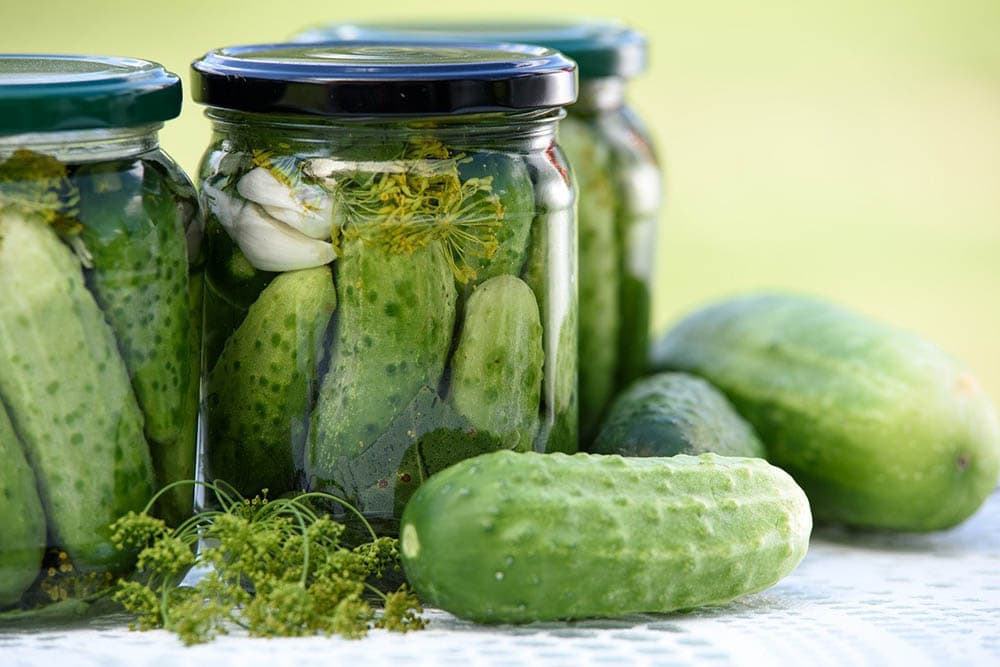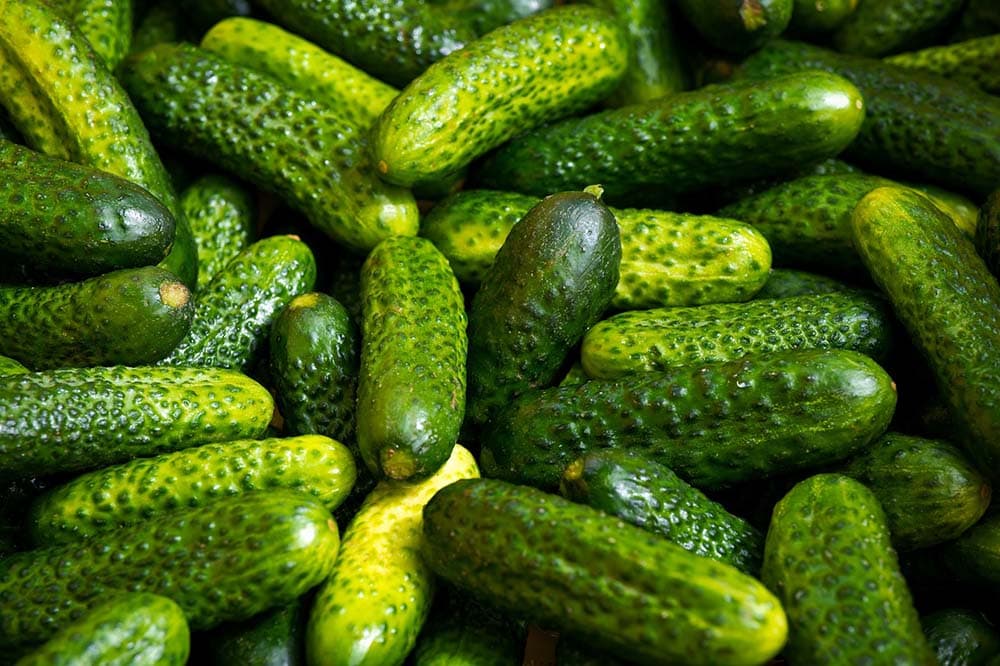10 Types of Pickles (with Pictures)
-
Shea Cummings
- Last updated:

You’ve probably seen some of the options available at your local supermarket. But you may be surprised to learn that there are a lot of variations when it comes to pickles. Whether you’re looking for sweet, spicy, or anything in between, there is probably an option you’ll enjoy.
Keep in mind while you’re reading this list of 10 types of pickles, even within these types, there are variations to the recipes. And if you’re pickling your own cucumbers, then you’re free to modify a recipe to your own personal taste.
The 10 Types of Pickles
1. Dill Pickle

When someone thinks of a pickle, chances are high that a classic dill pickle is the first one that comes to mind. They’re available in many forms, from whole pickles to slices or spears. There is no single dill pickle recipe, but one thing they all have in common is the heavily dill-flavored brine.
Some common variations of the dill pickle include different pickling spices, hot peppers, and garlic. If you’re making your own, it’s easy enough to modify recipes to suit your taste.
2. Sweet Pickle
These pickles may be sweet but aren’t necessarily desert pickles. However, because of the sugar in the brine, they have a sweet and tangy bite that makes a great addition to certain meals. For example, sweet pickles go great on a juicy burger.
Recipes for sweet pickles typically call for two main ingredients: vinegar and sugar. However, they may also contain other spices or aromatics, such as thinly sliced onions.
3. Cinnamon Pickle
You probably won’t find these pickles all year round, but they’re fun ones to try when the Christmas holidays come around. Instead of the green or yellow pickles you’ve come to expect, these are a bright, vibrant red color. They are a change from a traditional pickle in two major ways: most recipes call for several cinnamon sticks, and cinnamon heart candies are typically used as well.
4. Bread & Butter Pickle
Bread and butter pickles are actually a form of sweet pickle. The recipe dates back to the 1920s to some farmers who wanted to brand and trademark the recipe for their sweet pickles. These pickles are a little more on the sweeter side but retain plenty of that salty bite you expect in a pickle
In addition, the normal ingredients in a sweet pickle, bread and butter pickle recipes typically include mustard and celery seeds. But plenty of variations are still considered a bread and butter pickle.
5. Kosher Dill Pickle
Kosher pickles are another type of common dill pickle that you’ll find on the shelves. Their name comes from the recipe’s roots, which are Kosher salt brine and copious amounts of dill and garlic. Other than the Kosher salt, the other thing that sets Kosher dills apart from regular dill pickles is that they must contain garlic, as that’s part of the original recipe.
6. Polish & German Pickle
These pickles are very similar to a traditional dill pickle and use the typical ingredients. But there are a couple of things that make them different. The main thing is that some extra ingredients usually give these pickles more kick. Peppercorns, mustard seeds, and caraway seeds are all common extra ingredients. In addition, these pickles are usually pickled in wooden barrels, which adds to their unique flavor.
7. Candied Pickle
You probably won’t put a candied pickle on a sandwich or a burger, but they do make a delightful sweet snack. The cool thing about candied pickles is that they are easy to make. All you have to do is cut a pickling cucumber into slices, then coat it in a mixture of cider vinegar and sugar—emphasis on the sugar to give it a candied and sweet flavor. Some variations to this recipe include a hot and sweet pickle or a salt-free pickle.
8. Sour Pickle
Unlike many other pickles, a sour pickle is actually pickled in a vinegar-less brine. Instead, they go through a fermentation process that uses water, spices, and pickling salt. As a result, these pickles don’t have that bite you expect in a pickle; they’re simply sour. Depending on how long they are fermented, they are either considered half-sour or full-sour. Around 6 weeks of fermentation is when they are deemed full-sour.
9. Gherkin Pickle

Essentially a gherkin (pronounced gur-kin) pickle is a tiny dill pickle. These small pickles are often marketed as baby dills or petite dills at the supermarket. They are especially popular in Germany. The biggest thing that sets these pickles apart from their counterparts is their size. Typically, they are 2 inches or smaller. In addition, their skin is much bumpier than a traditional pickle. If you’re into making your own pickles, these cucumbers are easy to grow in many places because of their size.
10. Hungarian Pickle
Hungarian pickles, also known as kovaszos uborka, are unique in how they are made. These are another vinegar-free pickle fermented in a mixture of water, salt, and pickling spices. The key ingredient: bread. When the jars of cucumbers and their pickling mixture are put in the sun, the yeast in the bread does the vinegar’s job of pickling.
Are Pickles Healthy?
Pickles have an extremely high salt content, so they are not good for us when consumed in large amounts. However, if you can eat them in moderation, there are a few surprising health benefits:
- Encourages good gut health with helpful probiotics.
- They may help with muscle cramps because they help replenish electrolytes.
- Helps maintain healthy blood sugar levels.
- High in beta-carotene, which is an antioxidant that your body converts to vitamin A.
Conclusion
One thing that is very attractive about pickles is that they aren’t expensive. In most places, you can grow cucumbers in your garden. Then, you can turn them into delicious, homemade pickles with only a few ingredients. And contrary to what some may think, many recipes are ready to eat after only a few days.
Featured Image Credit: Natali_Ploskaya, Shutterstock
Contents

